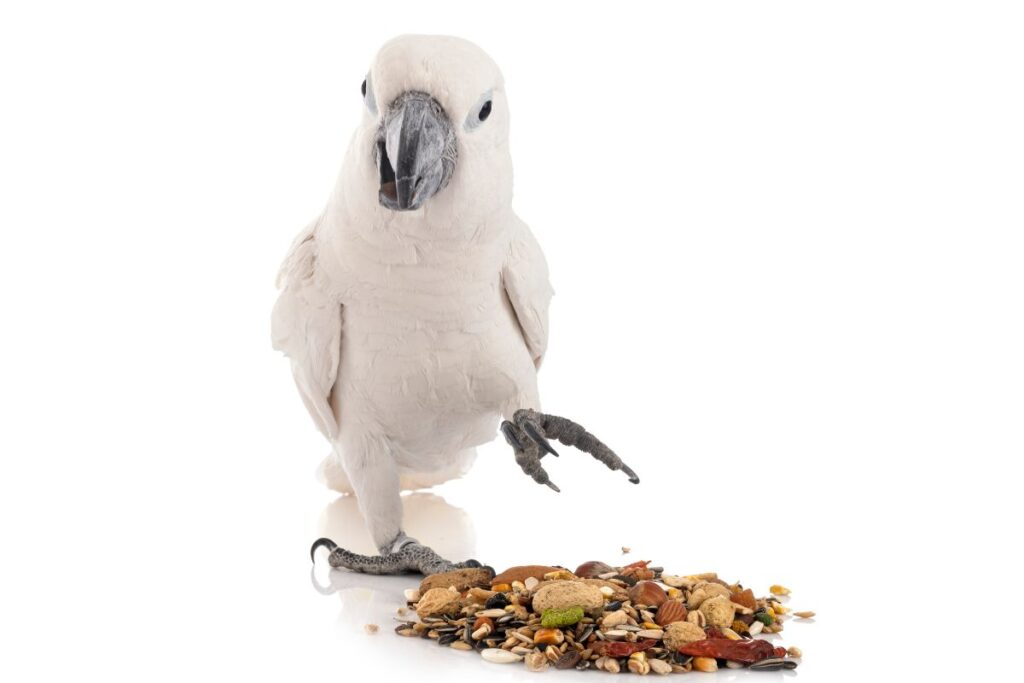Parrots, like cockatoos, are famous for their ability to mimic words and phrases. But did you know that the human language is not the only thing cockatoos can imitate? If you are lucky enough to have this bird as a pet at home, you will know that there is one common thing humans and cockatoos enjoy – dancing.
But why do cockatoos dance?
Key Takeaways
This article will discuss the following:
- Reasons why cockatoos dance
- How cockatoos recognize the beat of the music
- How to tell if a cockatoo likes you
Cockatoos dance when they are happy and excited. Their moves include bobbing their heads up and down, kicking their feet, and showing off their plumage. Some cockatoos can match their movements to the beat of the music.
Cockatoos are affectionate birds. So, in this article, we will tackle these birds’ body language when they want to show affection.
Why Do Cockatoos Dance?

Dancing is a common thing humans do. But have you ever heard of a dancing cockatoo? These birds are one of the funniest feathered companions humans can ever have. For this reason, it is no longer surprising if they will do things that can entertain their caretakers.
Moreover, the body language of a cockatoo says almost everything about how they feel.
Reasons Why A Cockatoo Dances
There are three reasons why a cockatoo dances:
- happiness
- excitement
- courtship
Cockatoos get excited when they hear music, especially if the music is lively. They dance to show their caretakers they are happy, or the music makes them feel good.
Male cockatoos use their moves in the wild to court their potential mate. The movements, including showing off their crests and plumage, are the male cockatoo’s way of persuading a female cockatoo. But in domesticated cockatoos, happiness and excitement are the usual reasons for dancing.
According to a research article published in Science Advances, some species other than humans can produce communicative displays with precise timing and coordination. As cockatoos are intelligent birds, some can even match a sound’s beat with their moves.
The most common move your feathered friend will make when it is dancing is bobbing its head up and down. If your pet has some moves, it may kick its legs to the beat from side to side. The happier your cockatoo is, the better its dance moves will be.
For instance, if your cockatoo is extremely excited about something, it may raise its crests, scream, and flap its wings while dancing.
Why Do Cockatoos Dance When They Are Happy
While dancing is a cockatoo’s way of showing excitement and happiness, it is also an instinct. Apart from this fact, these birds love getting their caretaker’s attention. They like it when you adore and praise them, so they will do what they know you enjoy.
It will pick up this behavior if you often dance to music in front of your cockatoo. Dancing in front of your feathered companion will encourage it to do the same.
Science, Music, And A Cockatoo’s Brain
Have you ever wondered how your pet cockatoo can match its movements to the beat of the music? Dr. Aniruddh Patel from San Diego’s Neurosciences Institute conducted a study about Snowball. This male sulfur-crested cockatoo became famous for its dance moves.
Dr. Patel observed Snowball while it was housed in an environment filled with a small TV and a CD player, thus exposing the cockatoo to music.
The study found that beat perception and synchronization (BPS) are not unique to humans. Instead, some animals, like cockatoos, can adjust their moves according to a music beat and tempo. The reason is that this bird’s brain links to the motor and auditory areas.
How To Tell If A Cockatoo Likes You
Bird enthusiasts call cockatoos the velcro birds due to their affectionate and cuddly nature. These birds like cuddling with their caretakers and would love all the attention they can get. The phrase “personal space” is a thing for these birds.
For this reason, it is easy to tell whether or not a cockatoo likes you.
Your cockatoo will try to get your attention.
Getting a bit of your personal space can make your cockatoo feel neglected. As a result, it will show off its crests and wings in hopes of getting your attention. If showing off and moving around does not work, your cockatoo will scream to call you.
A cockatoo outside its cage may even fly and land on your shoulder and peck your neck lightly until it gets your attention.
Feather-puffing
Cockatoos puff out their feathers, crouch their head down, stand on one foot, and half-close their eyes while trying to sleep. These birds are essentially letting their guard down when they rest this way around you. According to a short report published in Behavioral Processes, facial feather ruffling is a cockatoo’s indicator of positive emotion and a relaxed state.
So, if your feathered friend makes these gestures around you, it can signify that it likes you.
Imitates what you do
As mentioned, your cockatoo may learn to dance by imitating how you enjoy music. In the wild, these birds copy their mates actions when they have a close bond with each other.
Try making sounds in front of your feathered companion. If it looks entertained by what you are doing or imitates the sounds you make, it indicates that your pet likes you.
Gives you kisses
Beaking or nibbling is a body language domesticated cockatoos do when they like their caretakers. It is also something that you should not mistake for a bite. If your pet bites your finger without force, it is nibbling – a positive sign of affection.
It allows you to handle it.
Cockatoos are popular for their friendly nature. However, they will only show affection to people whom he trusts. So, if your cockatoo allows you to handle and cuddle with it, it is a tell-tale sign that it likes you.
Final Thoughts
Cockatoos are not only intelligent and affectionate; they are also famous for doing things to entertain their human companions. For instance, your feathered friend may show off their beauty to attract your attention.
There are two reasons why a cockatoo may dance – excitement and happiness. If your bird sees how you enjoy music, it will imitate your moves.
These Articles May Also Interest You
- Pink Cockatoo Price Guide of 2023
- Cockatoo Umbrella Price (3 Things You Need to Know)
- Black Palm Cockatoo Price (Plus Amazing Facts About The Black Palm Cockatoo)
- Cockatoo Vs. Cockatiel (A Comparison)
- 4 Reasons Why Parrots Dance
Sources
- Heinsohn, Robert, Christina N. Zdenek, Ross B. Cunningham, John A. Endler, and Naomi E. Langmore. “Tool-assisted rhythmic drumming in palm cockatoos shares key elements of human instrumental music.” Science advances 3, no. 6 (2017). doi: 10.1126/sciadv.1602399. Accessed February 16, 2023.
- Patel, Aniruddh D., John R. Iversen, Micah R. Bregman, Irena Schulz, Charles Schulz, and C. San. “Investigating the human-specificity of synchronization to music.” In Proceedings of the 10th International Conference on Music Perception and Cognition, pp. 100-104. Sapporo; Adelaide: Hokkaido University; Casual Productions, 2008. https://www.researchgate.net/profile/John-Iversen-2/publication/252318040_Investigating_the_human-specificity_of_synchronization_to_music/links/00b49536d58cbcc069000000/Investigating-the-human-specificity-of-synchronization-to-music.pdf. Accessed February 16, 2023.
- Bertin, Aline, Arielle Beraud, Léa Lansade, Baptiste Mulot, and Cécile Arnould. “Bill covering and nape feather ruffling as indicators of calm states in the Sulphur-crested cockatoo (Cacatua galerita).” Behavioral processes 178 (2020). DOI: https://doi.org/10.1016/j.beproc.2020.104188. Accessed February 16, 2023.





